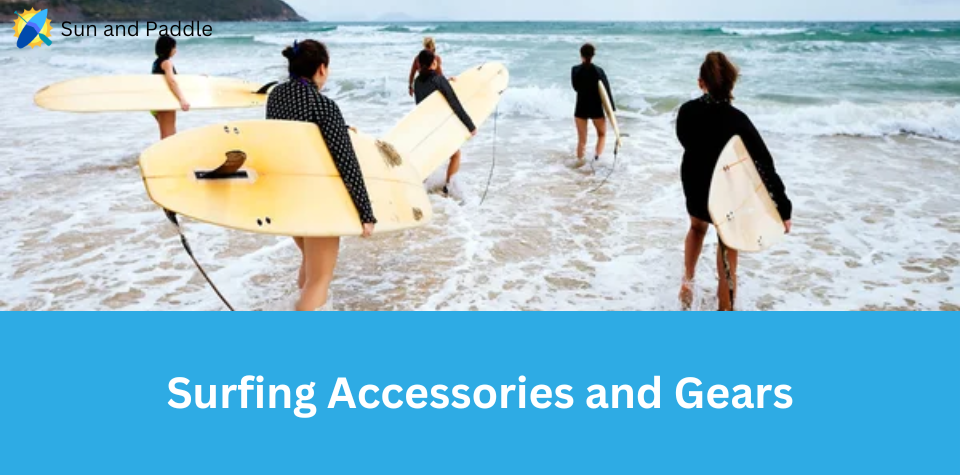As a surfing enthusiast, it’s essential to make sure you have the right gear and accessories when hitting the waves. Whether you’re a beginner or a seasoned surfer, wearing the right surfwear and using the proper equipment can greatly enhance your surfing experience, increase stability on your surfboard, and keep you protected from the sun and other elements. By investing in quality, eco-friendly surfing gear, you not only contribute to the preservation of the environment but also ensure optimal performance as you ride the waves.
When it comes to surfboards, finding the ideal one for your skill level and preferences is key. For beginners, selecting a larger, more stable foam board is recommended, as it provides a forgiving surface for the inevitable falls while learning. As you progress and gain more experience, you can explore the various surfboard types available, tailoring your choice to your style and the types of waves you’ll be surfing.
Aside from having the perfect surfboard, there’s additional essential gear and accessories that will enhance your session. Wearing a wetsuit or rash guard can provide warmth in cool waters and protection from the sun, while leashes – or ‘leg ropes’ – are an important safety feature that keep your board always within reach. Other useful accessories include surf wax, sunscreen, and GoPro cameras to capture your adventures. Remember to consult with experts at a surf shop or fellow surfers to find the most suitable gear for your needs.
Fins
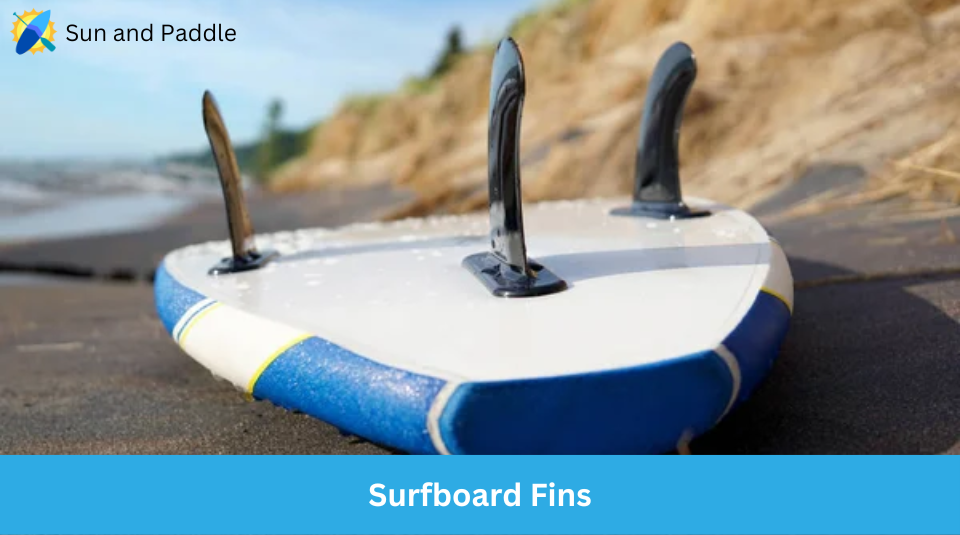
Fins are crucial accessories for your surfboard as they enhance stability, control, and maneuverability while riding waves. They are available in various shapes and sizes, each imparting different performance qualities to your board.
To install surf fins, carefully slide them into the fin boxes located on the underside of your surfboard. Make sure the screws align with the holes in the fins before tightening them securely. This will ensure the fins remain in place while you’re surfing.
When choosing fins for your surfboard, start by considering your weight as it plays a significant role in determining the appropriate fin size. Also, take a look at your board’s fin configuration or setup, which can accommodate anywhere from 1 to 5 fins. The type and number of fins you use will significantly impact your surfing experience.
Some common fin configurations include single fin, twin fin, thruster (3 fins), quad fin, and 5-fin setups. Each configuration offers distinct advantages and drawbacks in terms of maneuverability, speed, and stability.
It’s essential to select fins that match your skill level and the conditions in which you’ll be surfing. Keep a fin key handy, as it will enable you to swap out fins as needed. This small tool facilitates adjustments, allowing you to customize your surfboard setup and enjoy an optimal surfing experience.
In summary, fins are vital surfing accessories that, when chosen and installed correctly, can greatly impact your surfboard’s performance and your overall enjoyment of the sport.
Surf Wax/Traction Pad
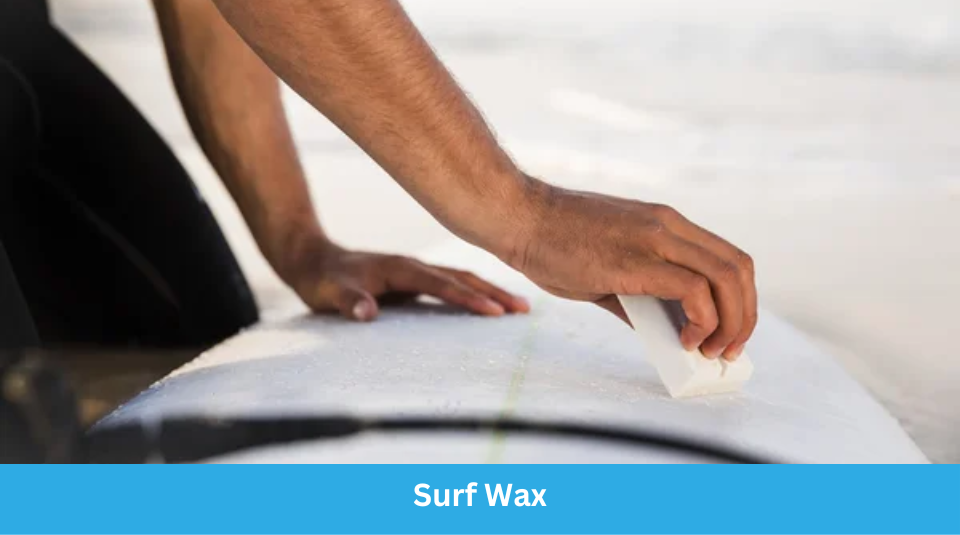
When it comes to improving your grip on a surfboard, surf wax and traction pads are essential accessories. These items provide the necessary traction to keep you from slipping off your board while catching waves.
Surf Wax is typically applied to the deck (top side) of traditional fiberglass surfboards. To apply surf wax to your board, you’ll want to create a criss-cross pattern on the deck. This ensures an even distribution of the wax and maximizes its grip-enhancing properties. Keep in mind that surf wax requires occasional maintenance, meaning you’ll need to reapply it after some sessions to maintain its effectiveness.
Traction Pads are another option for enhancing grip on your surfboard, especially on foam or soft-top surfboards. These pads are made of EVA foam and feature a textured surface that provides grip and stability without needing to apply wax. To use a traction pad, attach it to the deck of your surfboard following the manufacturer’s instructions.
When selecting between surf wax and traction pads, consider factors like personal preference, type of surfboard, and surf conditions. Remember, a secure grip on your surfboard is crucial for a successful and enjoyable surfing experience. Ensure you have the right accessories on hand and enjoy the waves with confidence.
Leash
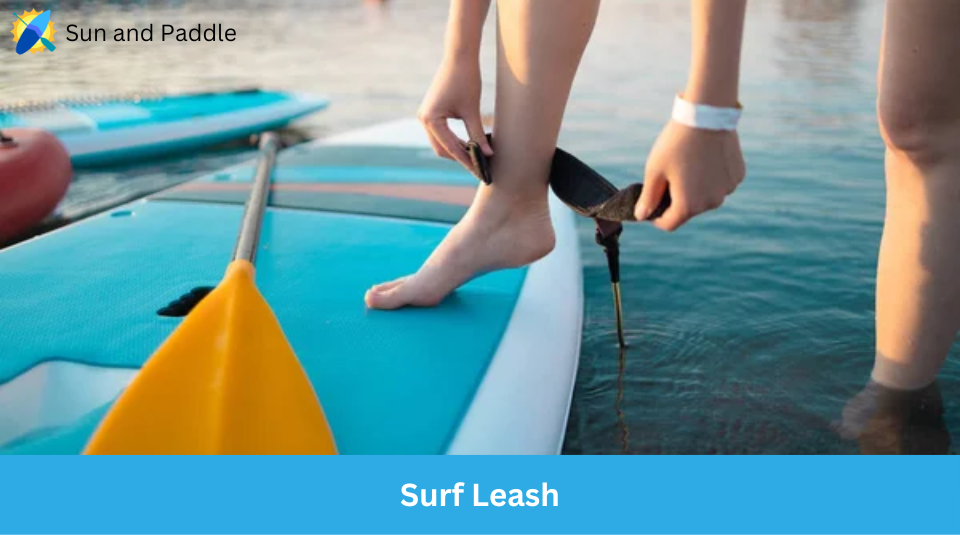
A surf leash is one of the most essential surfing accessories you should bring and wear. It is designed to keep your surfboard from drifting away from you in case of a wipeout, ensuring your safety and preventing potential harm to other surfers or swimmers nearby.
When selecting a leash, consider the length of your surfboard, as your leash should be roughly the same length or slightly longer than your board. This will allow you enough space for maneuvering while avoiding getting tangled up.
Additionally, the thickness of the leash is a crucial factor, with thicker leashes providing more strength and durability for bigger waves or larger surfboards. If you’re just starting out or prefer smaller waves, a thinner leash should suffice.
To use a leash, simply fasten the cuff securely around your ankle or calf, ensuring that it feels comfortable and does not restrict your movement. Most cuffs come with padding and easily adjustable straps for a customized fit. The other end of the leash should be attached to the leash plug found at the tail of your surfboard. Make sure the cord is tangle-free when attaching it to your board.
Lastly, it’s important to regularly inspect your leash for wear and tear, especially before hitting the waves. Check for damage to the cord, swivels, or cuffs, and replace your leash if needed to ensure your safety and that of others around you.
Surfing Shoes
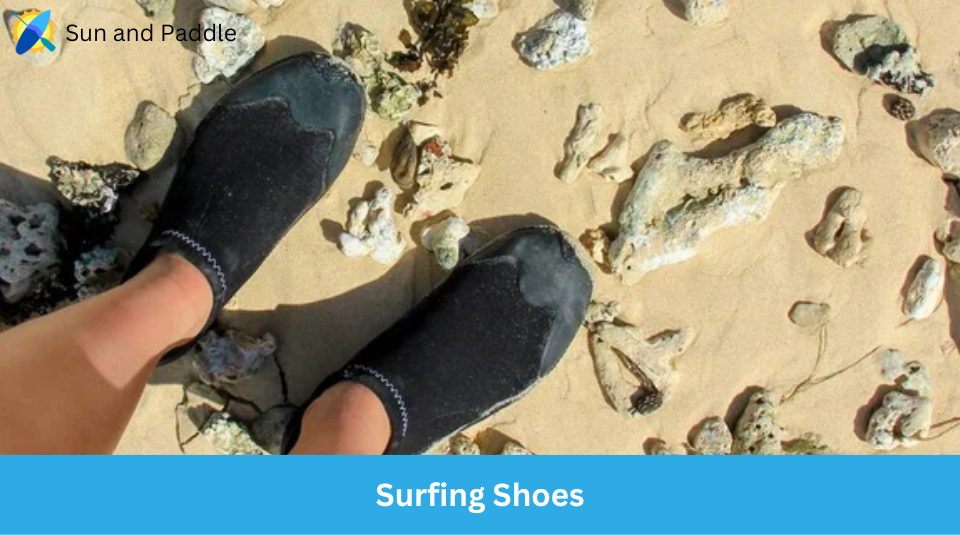
When you’re gearing up for a surfing session, one essential piece of equipment to consider is surfing shoes, also known as booties. These neoprene footwear are specifically designed for surfing, offering several benefits to enhance your overall experience in the water.
First and foremost, surfing shoes provide crucial protection for your feet. While surfing, you may encounter rough surfaces, rocks, or sharp objects that can cause cuts or injuries. Wearing booties can help shield your feet from these potential hazards and prevent unnecessary accidents.
Thermal insulation is another significant advantage offered by surfing shoes. Colder water temperatures demand proper gear to keep you warm, and booties are designed to retain heat, ensuring that your feet stay comfortable even in chilly conditions. When selecting a pair of surfing shoes, consider the water temperature of your surfing location to determine the appropriate thickness for your booties.
In addition to protection and warmth, surfing shoes enable better traction on your surfboard, ultimately improving your control while riding waves. This added grip is essential for executing turns and maintaining balance on the board, especially in more challenging conditions.
To round out your surfing wardrobe, don’t forget to pack board shorts or boardshorts. These lightweight and quick-drying shorts are designed specifically for wearing in the water, providing comfort and ease of movement while you surf. With various styles and materials available, you can opt for a pair that best suits your surfing needs and personal preferences.
In conclusion, well-equipped with proper gear is essential to ensure a safe, comfortable, and enjoyable surfing experience. Don’t underestimate the importance of booties and other necessary accessories, and you’ll be ready to ride the waves with confidence.
Surfing Gloves
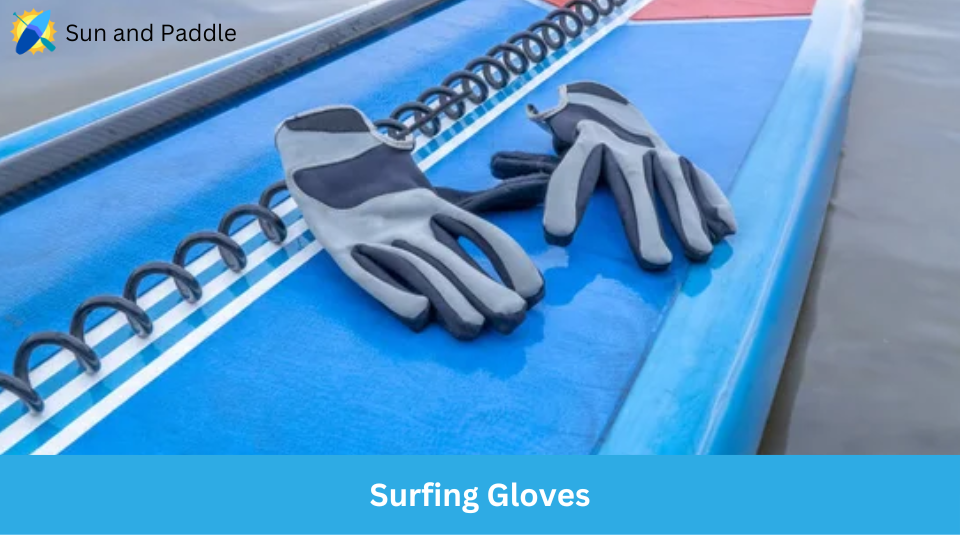
As a surfer, wearing the right gloves is essential to ensure comfort and safety while riding the waves. Surfing gloves, made from neoprene material, are designed to keep your hands warm in cold water and protect them from chafing while paddling. In addition, they provide sun protection, which is necessary for surfers who spend extended periods in the sun.
When considering a pair of surfing gloves, the water temperature plays a significant role in your selection. For example, the O’Neill Psycho Tech 3mm Surf Gloves are suitable for temperatures below 50°F, providing warmth and durability. Similarly, the Quiksilver Marathon Sessions are easy to use and a great option for cold waters. As an eco-friendly choice, the Patagonia R3 Yulex Gloves are an excellent option for environmentally conscious surfers.
Other popular options include the Neosport Neoprene Surf Glove, the Hyperflex Men’s Access Surf Glove, the Vissla 7mm 7 Seas Wetsuit Mittens for very cold conditions. If you’re a beginner, consider the Billabong 3mm Furnace Wetsuit Gloves as a reliable entry-level option. The XCEL 3mm Drylock Texture Skin 5-Finger Wetsuit Gloves are also highly rated, known for their superior performance.
When choosing your gloves, consider the style that best suits your needs. Five-finger gloves offer the most dexterity and natural feel but may not offer maximum warmth. Lobster claw gloves provide a better balance between warmth and dexterity. No matter what you select, be sure to find gloves that fit well and enhance your surfing experience.
Surfing PFD (Life Vest, Life Jacket)
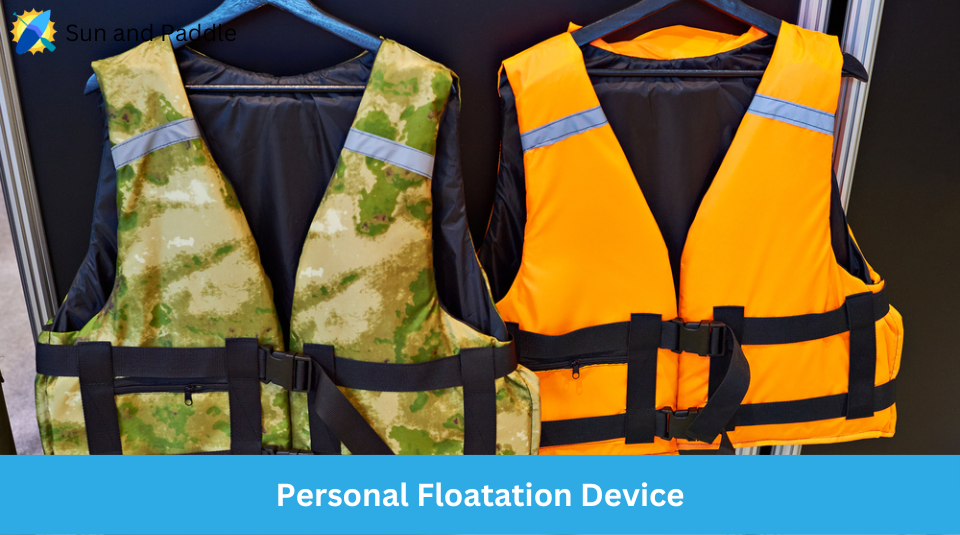
As a beginner in the world of surfing, safety should be one of your main priorities. One accessory that you might consider using is a Personal Flotation Device (PFD), also known as a life vest or life jacket. PFDs are designed to keep you afloat in case of an emergency, providing an additional layer of safety while you’re in the water.
Although PFDs can provide an extra sense of security for beginners, it’s important to note that they are not commonly used by surfers. This is because PFDs can hinder mobility and make it difficult to perform certain surfing maneuvers. Additionally, wearing a PFD might get in the way of executing duck diving and paddling, as well as restrict your movement.
If you still opt to use a PFD while surfing, it’s essential to choose the right one. Look for lightweight and non-bulky options that offer less restriction to your movements. Moreover, consider the water temperature when picking the right PFD, as some may offer additional thermal protection, while others may not.
In terms of carrying your gear, a backpack could be a convenient option for transporting your wetsuit, surfboard accessories, and any additional safety equipment you want to bring along. Look for a surf-specific backpack with waterproof compartments or external straps to secure your gear, and ensure it has a comfortable fit for easier transportation.
In summary, a PFD can offer added safety, especially for beginners, but it’s crucial to weigh the pros and cons before deciding to wear one while surfing. Understand the potential limitations of PFDs and choose the right one based on your needs, water temperature, and desired level of safety.
GoPro Holder
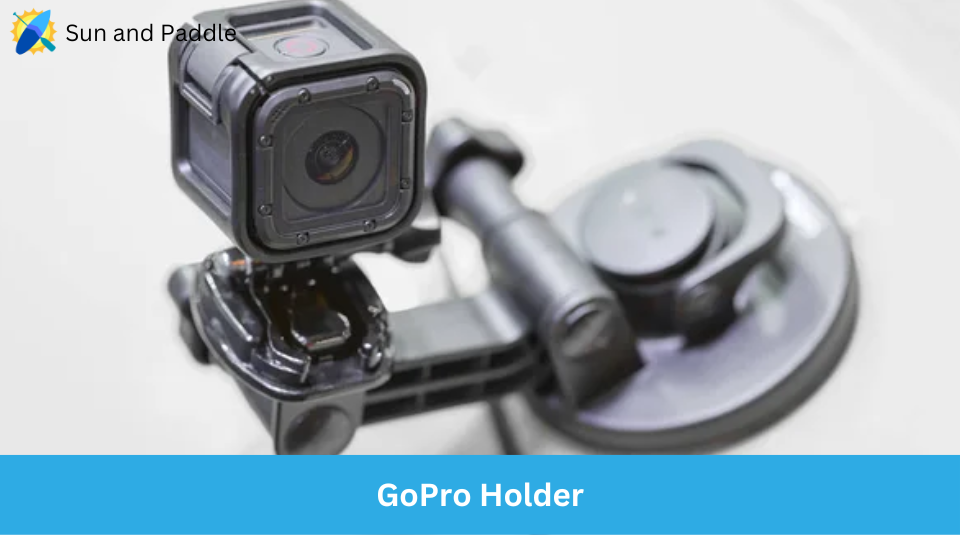
A GoPro holder is essential for surfers looking to capture their rides and record footage from their perspective. With a variety of accessories available, you can find the perfect GoPro holder suited specifically for surfing.
One of the most reliable options is the official GoPro Surfboard Mount. This accessory anchors at the top of your surfboard, allowing you to focus the footage on yourself as well as the waves. The Surfboard Mount is designed for maximum holding strength, making it ideal for high-intensity activities like surfing.
Another useful accessory is the GoPro Hand + Wrist Strap. By strapping your GoPro camera to your hand or wrist, you can capture ultra-immersive point-of-view footage and unique selfies while in the water. This mount offers 360-degree rotation and tilt, enabling you to adjust your capture angle on the fly.
For those looking for a hands-free option, consider using a mouth mount. The comfortable rubber mouthpiece and bite supports ensure stable footage, while the built-in air channel allows for unrestricted breathing. A low-profile lanyard keeps your camera close at hand, making it easy to retrieve whenever needed.
Don’t forget that selecting the right memory card is crucial for smooth, uninterrupted clips. It’s recommended to use a high-performance memory card specifically designed for action cameras like GoPro.
In summary, a GoPro holder is an indispensable accessory for every surfer looking to capture their experiences on the waves. Whether you choose an official surfboard mount, a hand + wrist strap, or a mouth mount for hands-free recording, you’ll be equipped with the right gear to document your surfing adventures.
Storage Bag
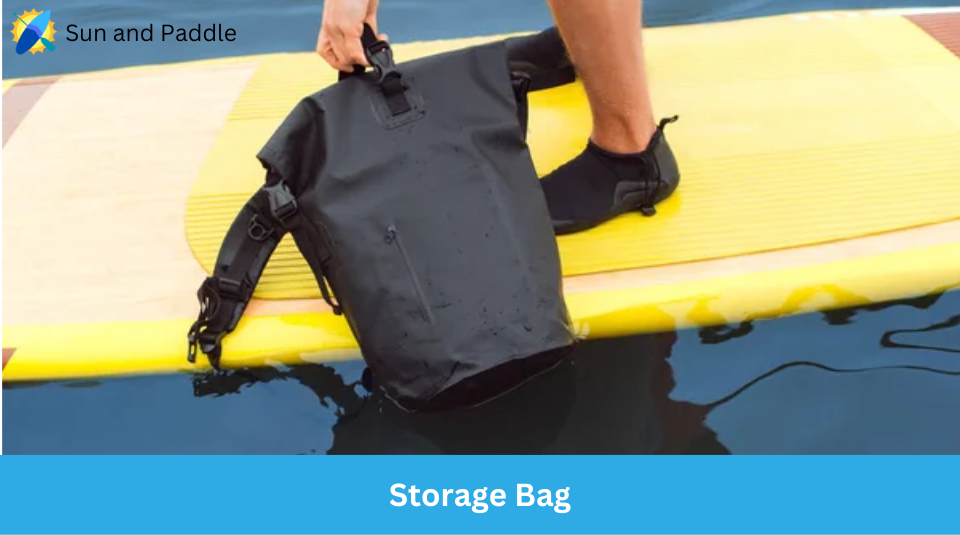
When planning a surf trip, investing in a reliable storage bag ensures that your surf equipment and accessories stay organized and protected. A comprehensive storage bag should have ample space to accommodate your surfboard, fins, wax, leash, and other small accessories.
A surfboard bag is an essential piece of gear, as it protects your board from damage during travel. Look for a bag with adequate padding and tear-resistant fabric. Several large storage pockets can also be beneficial for housing items like your wetsuit, fins, and other gear. Proper maintenance of your surfboard bag is crucial; rinse it with fresh water after each use to remove salt and sand, let it dry thoroughly before storing your surfboard, and inspect it regularly for signs of wear and tear.
Besides keeping your surfboard safe, a surf travel bag should also cater to other accessories you’ll need on your trip. For example, consider carrying a lightweight travel towel, rash guard, or wetsuit to protect your body from sunburns and surf rash. When it comes to smaller items like sunscreen, wax, or fin keys, allocating a specific pocket or compartment within your storage bag can help you stay organized and ready for action.
Lastly, a waterproof dry backpack can be a practical addition to your surf gear. Not only will this bag offer convenient storage for wet items like your wetsuit, but it will also keep your dry belongings protected from any accidental splashes or spills.
In summary, a well-organized and protective storage bag system is a must for any surfing trip. By carefully selecting and maintaining your surfboard bag, accessory compartments, and waterproof dry backpack, you can enjoy a hassle-free and enjoyable experience in and out of the water.
Storage Bag with Wheels
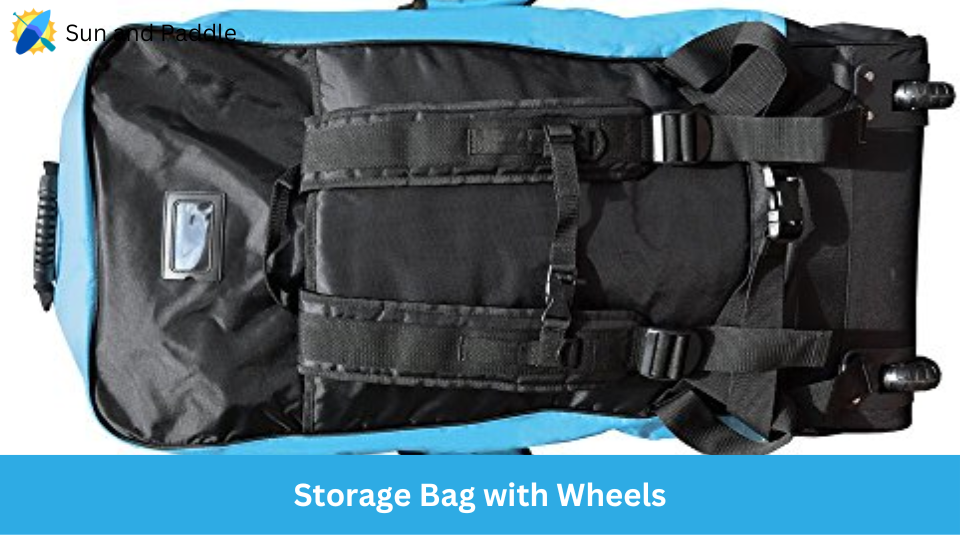
When preparing for a surf session, it’s crucial to have a reliable and convenient way to transport your gear. A storage bag with wheels can be a game-changer for surfers, offering an easy and hassle-free method for carrying your equipment to and from the beach. With added wheels, maneuvering the bag becomes a breeze, even when loaded with bulky or heavy items like surfboards and wetsuits.
A quality storage bag should have ample space for your surfboard and all the necessary accessories. One option to consider is a surfboard-specific travel bag, designed specifically to hold and protect your board. These bags typically feature padded interiors and reinforced exteriors to safeguard your board from damage during transportation. Remember, it’s essential to choose a bag that fits your surfboard’s size and shape.
In addition to your surfboard, the bag should have room for other essential surfing accessories, such as fins, leashes, wetsuits, and towels. Many surf bags include compartments and pockets designed to keep smaller items organized and easily accessible.
Another advantage of a wheeled storage bag is the ability to travel with it. If you’re planning a surf trip, having a sturdy bag with wheels simplifies the process of navigating airports and other transit hubs. Make sure to pick a bag that meets airline size and weight restrictions, so you don’t run into any issues during your journey.
In conclusion, investing in a wheeled storage bag enhances your overall surfing experience, providing a convenient method for transporting your gear and keeping it protected. By choosing a high-quality bag that accommodates your surfboard and accessories, you’ll ensure a smooth transition from your home to the beach, leaving you more time to focus on catching those perfect waves.
Straps for Securing Belongings
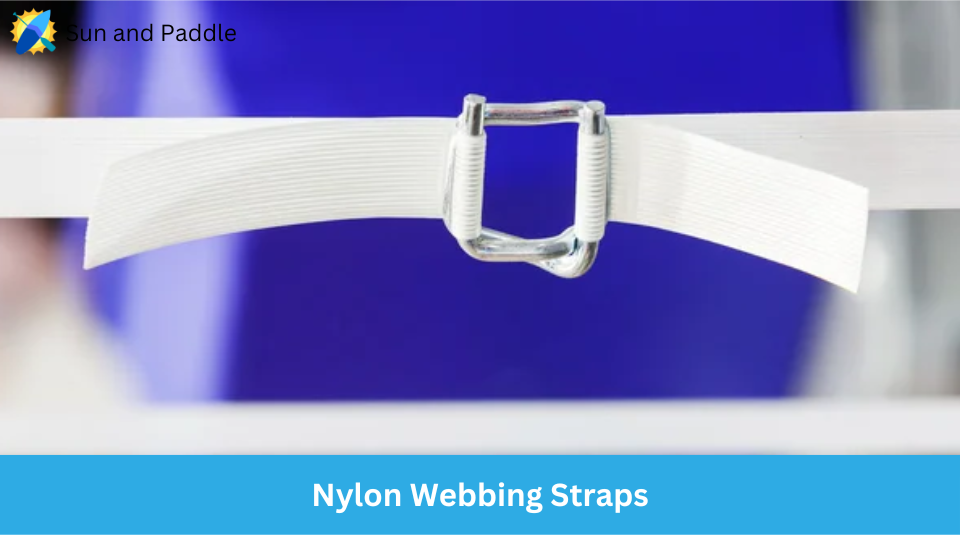
When preparing for a surfing trip, it’s essential to bring along the right accessories and gear for a seamless experience. One important aspect of your travel preparation is securing your belongings, such as surfboards and other equipment, when traveling to surf spots. Straps can be instrumental in ensuring your items are safely fastened during transportation.
Consider using nylon webbing straps with buckles to secure your surfboards to roof racks or inside your vehicle. These straps provide a strong hold and are much more secure than regular ropes. Ropes, especially when not tied properly, might loosen during transit and cause damage to your board or other equipment.
For an added layer of security, you could look into lockable straps. Products like Steelcore Lockable Security Straps feature an aircraft-grade aluminum buckle assembly that is powder-coated for corrosion resistance. They come with a custom-made double-butted key and are pick-resistant, providing you with peace of mind knowing that your equipment is secure from theft and damage.
When packing your belongings, don’t overlook the importance of a quality, well-organized backpack. It should have compartments for storing essential accessories such as wetsuits, fins, and wax. You might opt for a waterproof or water-resistant backpack if you anticipate being near or in the water. Properly packed gear will not only help you stay organized but also protect your items from damage during your surfing adventure.
In conclusion, investing in reliable straps and suitable backpacks is crucial for a stress-free surfing experience. By properly securing your belongings, you can focus on enjoying the waves and improving your skills with confidence.
Dry Bag
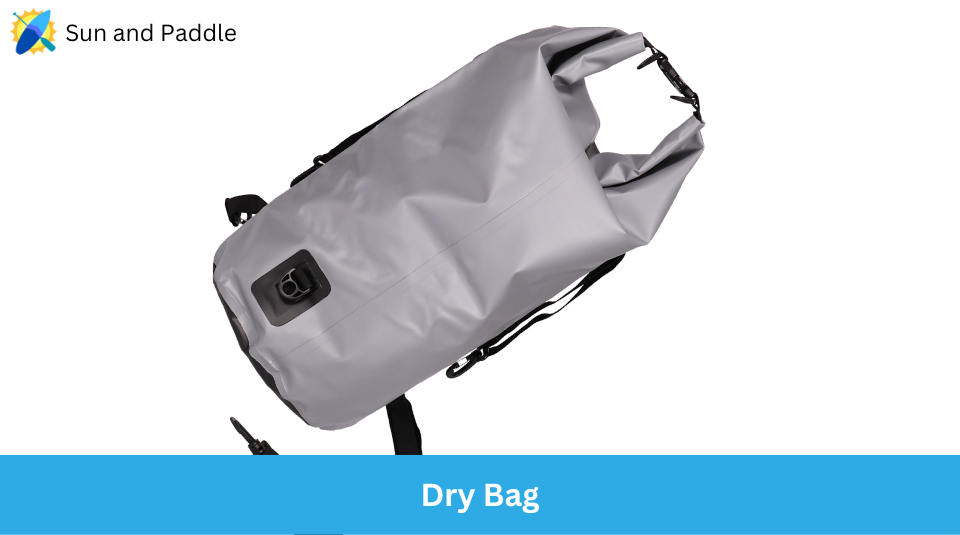
A dry bag is an essential accessory for any surfing enthusiast, as it helps you keep your personal items safe and dry during your water-based adventures. These waterproof bags are specifically designed to protect your belongings from water exposure, whether you’re surfing, paddleboarding, or even caught in heavy rain.
When choosing a dry bag for your surfing needs, consider factors such as material, size, and intended use. Most dry bags are made from durable materials like PVC or TPU, which provide an excellent barrier against water. Make sure to pick a size that suits your packing needs, whether it’s for storing essential valuables or even larger items like spare clothing.
Some dry bags come with additional features, such as multiple compartments or external pockets, to help organize your gear better. There are also dry bags designed specifically for certain types of water activity, so look for one that suits your surfing requirements.
When using a dry bag, proper sealing is crucial. Most dry bags use a roll-top closure system, which involves folding the top of the bag several times and then securing it with a buckle. By doing this, you create an airtight seal that keeps water out and your belongings dry.
In conclusion, keeping a dry bag as part of your surfing gear can greatly enhance your experience on the water. With a good-quality dry bag, you can keep your personal belongings safe and focus on enjoying the waves. So, make sure to include a dry bag in your list of surfing accessories and gear for your next trip.
Wet Suit
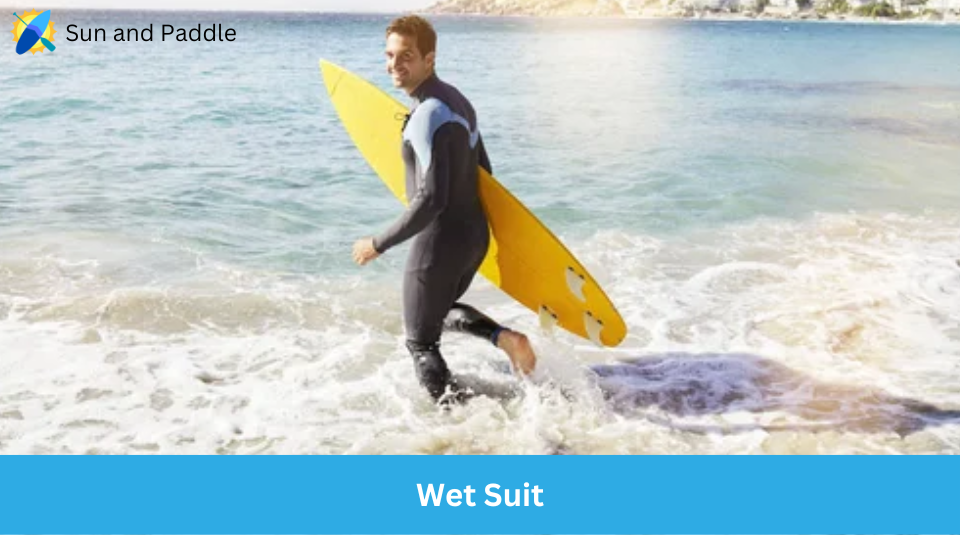
When preparing for a surf session, one of the most critical pieces of equipment you’ll need is a wetsuit. A wetsuit is made of neoprene material, and it’s designed to keep you warm while you’re in the water by trapping a thin layer of water between your skin and the suit. This layer of water is warmed by your body heat, ensuring that you stay comfortable and safe even as the water temperature varies.
Selecting the appropriate wetsuit thickness is essential, as it will depend on the water temperature during your surf session. Wetsuits come in various thicknesses, so it’s crucial to choose one that will keep you warm without overheating.
For water temperatures below 60°F (16°C), you’ll want to consider a thicker wetsuit, ranging from 4/3mm to 6/5mm, perhaps with a built-in hood for added warmth and protection. A hooded wetsuit will protect your head from cold and prevent significant heat loss, which is essential when surfing in colder conditions.
In water temperatures between 60-70°F (16-21°C), a 3/2mm full-suit would be more suitable. This thickness provides ample insulation while still allowing for good flexibility and freedom of movement in the water.
For water temperatures above 70°F (21°C), consider using a spring suit or a shorty, as they’re lighter and provide more breathability. These thinner wetsuits are ideal for warmer conditions, without sacrificing essential skin protection against the sun, rash, and reef cuts.
Always remember to check and consider the water temperature when choosing a wetsuit for your surfing session so that you can maximize your comfort and safety in the water. With the right wetsuit, you’ll be able to focus on catching waves and enjoying your time out in the surf.
Rail Tape
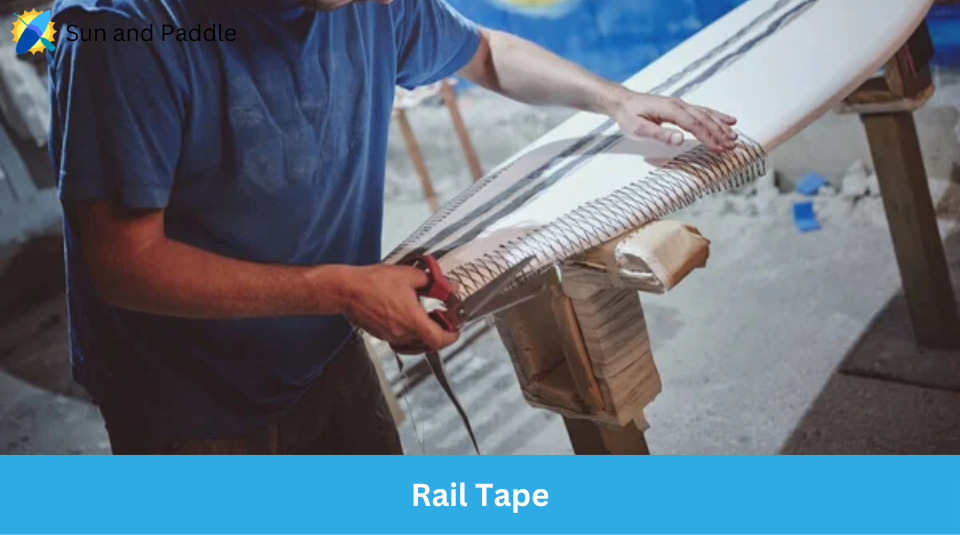
As a surfer, protecting your board is essential. One accessory you should consider is rail tape. This clear adhesive tape is specifically designed to protect the rails (sides) of a surfboard from dings, scratches, and damage, especially during transportation or while handling it outside the water.
Rail tape can be a particularly smart investment for those with plastic or fiberglass boards, as it helps prevent chips caused by paddles or other accessories. Most tapes are transparent and discreet, not featuring any brand prints, which makes them blend seamlessly with your board’s design.
While using rail tape, it is important to follow the installation process correctly to achieve the best results. First, clean the rails of your board to ensure dust-free and dry surfaces for optimal adhesion. Next, carefully apply the tape, smoothing it out as you go to prevent bubbles and wrinkles. Ensure that you cover the entire length of the rails to provide full protection.
Besides protecting your board, rail tape can also reduce drag on the rails, and offer improved grip. This makes it an excellent addition to your surfing equipment collection, whether you are new to the sport or an experienced surfer. In addition, rail tape can be easily replaced if it gets damaged, ensuring that your board remains well-protected throughout its lifetime.
In summary, rail tape adds an extra layer of protection to your board, helping to prevent damage caused by everyday wear and tear. It is an essential accessory that will not only extend the lifespan of your surfboard but also enhance your overall surfing experience.

